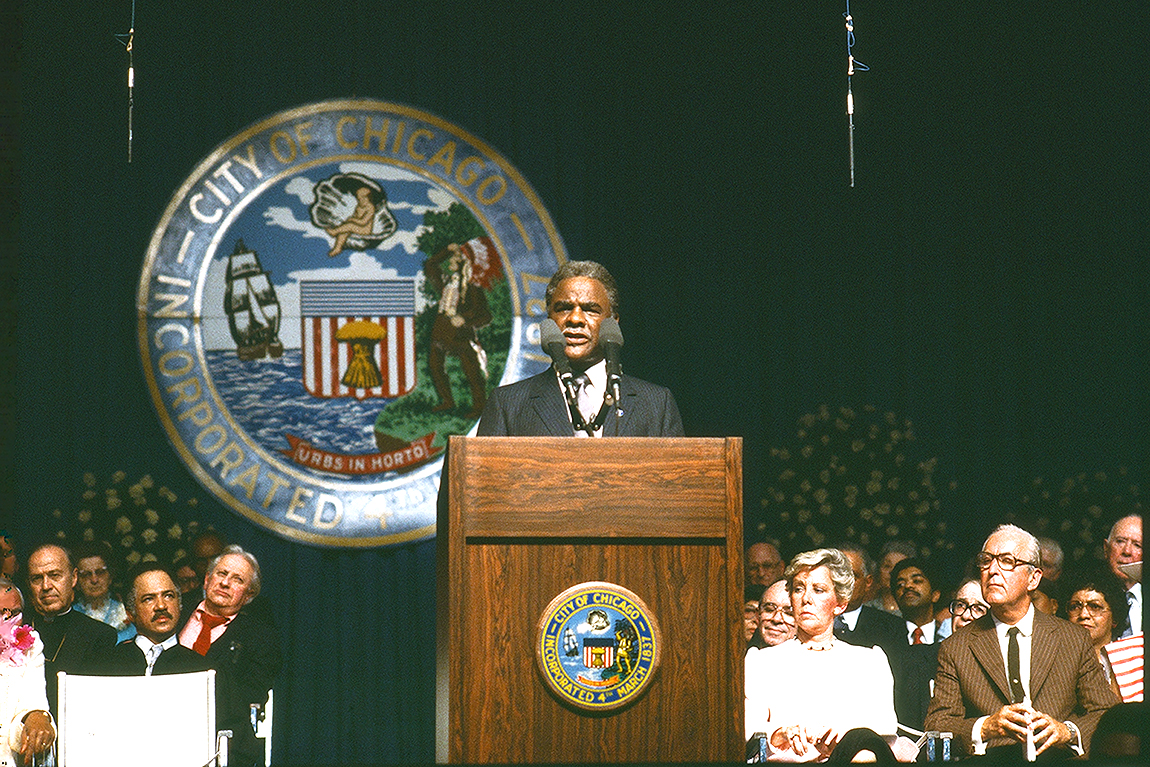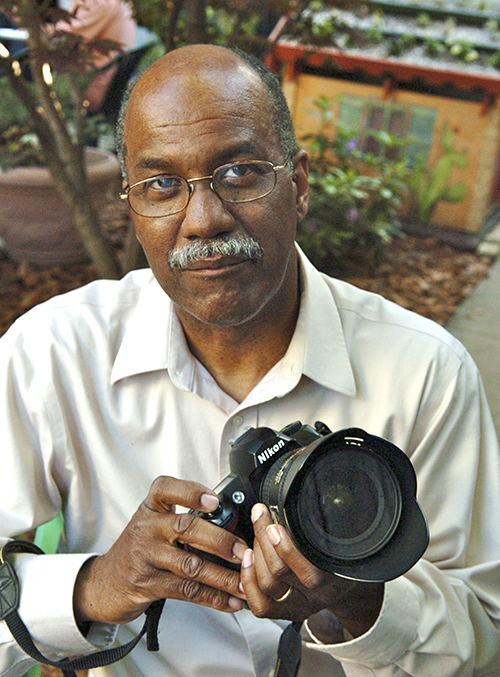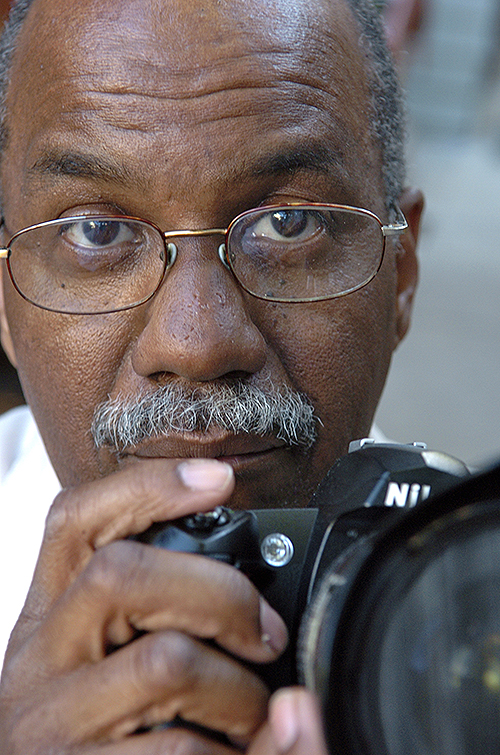Photo Journalist Brent Jones Recalls His Hizzoner

Picture by Brent Jones. Copyright © by Brent Jones.
Gregg Morris
So, we’re talking about all that exceptional stuff that you were doing way back when, yeah. It was way back when with many Blacks like me who got our college degrees and were trying to break into the corporate news media because we thought that was where the money and the prestige and the perks were. And you were doing it freelance, correct?
Brent Jones:
That’s right.
Gregg Morris:
So talk about your front page with Time magazine.
Brent Jones:
Well, actually it was Newsweek and it was the first time that a Black photographer had a Newsweek cover and it was especially gratifying because as you might imagine, there was lots of competition to get a picture that would end up on the cover.
I was with Harold Washington from just before he made his run and until his passing. I covered his funeral, also.
Many of my assignments back then were the result of my professional connection as a freelancing journalist with him. As I mentioned to you before, a number of people thought that I was actually on his staff because I was around him so much. I was privy to his daily schedule and came up with ways to be where he would be.
[Editor’s Note: The irony almost blew my mind. Essentially eschewing big city pack journalism, Brent Jones carved out his own J-niche on the run, as they say, which meant taking risks and developing instincts that journalists need to pursue the truth. Unlike other Chicago politicos, Harold Washington visited ethnic and diverse neighborhoods and communities of all stripes in racially polarized Windy City. He too was on a run. It was as if Washington’s political muse and Jones’ journalistic muse had a cosmic connection. Both, in a sense, were outliers.]
I was privy to his daily schedule. And so I could pick and choose to go wherever he was going. When I didn’t have an assignment from anyone else, I made my own assignment by going where Harold went. Harold was the news. And so I ended up picking up assignments from Time and Newsweek. [There were also other assignments he picked from other national news weeklies because of that.]
I was at that Catholic church, St. Pascal, [935 N Melvina Ave, Chicago, IL]. I went to the church and at first I couldn’t get in because of the demonstrators. I got some images of the protestors. [Jones eventually maneuvered his way inside the church to get pictures he wanted of Washington and others in Harold’s entourage, like Walter Mondale, walking into the church. But the threat of imminent violence kept Washington and the entourage from ever entering.]
He and Mondale didn’t come in. His staff decided it was too dangerous. I was directly in front of him all the while, but there were so many people mad out there. I had run to get in front of him. And I was going to get him entering the church, but the protest was so thick and so ugly that his people decided they shouldn’t even attempt to go in.
Well, they [the mob] were ugly. They weren’t going to let him in even though it had been arranged in advanced with the church pastor. Those in the crowd were completely against him; they were supporting his opponent. His opponent had been a classmate of Washington’s. They had been friends over the years. And, it was absolutely, absolutely ugly. [Editor’s Note: Republican Bernard Epton was Washington’s primary opponent.]
Gregg Morris asks about his photographic equipment.
Brent Jones:
I usually carried two cameras, sometimes three, because back in the old days, we shot color for color and black and white And most of the time we were shooting black and white, as opposed to color. Only, when trying to get something for a Newsweek, Time cover or for pictures inside the magazines, I would shoot color. Shooting transparencies early on was especially difficult. Color slide film was exacting and had to be spot on. It’s not like today when you go digitally and you can make colors whatever flavor you want them to be. But back then the color had to be right on. You could push film and maybe the slide film one stop. And pushing meant boosting the film [speed] faster than it was designed for.
And again, all of this was done under deadline pressure. So yeah, well, one camera’s is absolutely dedicated to color and the other two black and white. And if it was a real big assignment, then I’d have three cameras. So a lot of equipment.

Brent Jones. Picture by John H. White.
Gregg Morris asks about camera preference.
Brent Jones:
I was a Nikon person early on. Nikon made their equipment compatible. I was working on my own and my budget, my budget sometimes was paper thin. I needed to remain consistent with what I could support. The other thing was, Nikon had a repair place in Niles [Illinois]. And so if worse came to worse, I needed something repaired, I could drive there and the guys would actually fix problems, oftentimes on the spot. Things like that made a difference. So, yeah, I’m a loyal Nikon person.
Gregg Morris:
Okay. What were some of your scariest moments? And you can deal with that question any way you want for this interview.
Brent Jones:
I didn’t have the good sense to be afraid at St. Pascal the way that I should have been. Another photographer had warned me that I needed to get out of there because there were mad white folks and they were not just threatening, blustering, they were dead serious. And I took the hint and left and caught up with Harold Washington at another of the stops. And one day on another assignment I was out there in Marquette Park when the Klan had their rally and I got some pictures and then a policemen tugged my coat and said a camera crew had been run out of the park and it would be wise for me – I’m paraphrasing – to get my butt out of Marquette Park. And I made a few more pictures and strategically made my way to my car and got out. But that assignment wasn’t related to covering Harold.
[Marquette Park Rallies in the 60s]
[Harold Washington and the Politics of Race in Chicago by Manning Marable]
Discussions about access to Harold Washington
Brent Jones:
I had considerable access. Well, it started out … one of his press secretaries was a guy named David Potter. And Potter was a former assistant managing editor of the [Chicago] Defender. And I’d worked with him over a whole bunch of years and, and we were close. And so he made sure that I got notices of briefings, that I got the schedules.
Ted Kennedy was in Washington’s Congressional office one day when I was there. I had learned that Newsweek was trying to get a cover so I arranged to make portraits of Washington. And lo and behold, when I walked into one of the rooms, there was Ted Kennedy with Harold Washington. And so I got a picture of the two of them together. The picture that I made in Harold Washington’s office didn’t make it to the cover. I had mixed feeling what was selected by Newsweek.
Newsweek ended up calling it the Ugly Election. And they ran a picture of Harold scowling. And that was disappointing to me. Harold had a great smile and that was most of the time. He was very engaging and warm. And that’s what appealed to people. Even though I gave them quite a selection of pictures, they went with the scowl.
Another thing: Harold sent reporters to the dictionary to figure out what he had said; he was so articulate and just so much fun to listen to. And as you know, there were so many reporters who were trying desperately to trap, to trip him up … and he was just too fast on his feet. Like WBBM, John Madighan.
Gregg Morris:
Oh, wait a minute. I remember him. Yeah. My father was really into him, yeah.
Brent Jones:
[He recalls when Harold Washington appeared on a Radio WBBM Bob Madighan show and the radio host went for the jugular.] And he had just kind of spit it out. But anyway, I was there for the interview and Madighan was trying so hard to get him. Harold chewed him up, spit him out. It was wonderful. It was like Zorro carving the Z on somebody’s chest.
And that [reporters trying to trip up Washington] happened routinely. I’m looking at it now on my computer. People from Meet the Press came in and they did a Chicago version of Meet the Press just before the election. And Harold’s opponent was supposed to be there with him, but he didn’t show up. And that was a real fun interview also because Harold was just himself; they came with their questions and Harold just handled it.

Photo by John H. White.
More background
Brent Jones:
I had been doing considerable magazine work, I did work for Chicago magazine and I had done a many textbook pictures, and did work for Scott Foresman and [others] like that. And so that was pretty steady and good. But once the election started, then I was full focused on the election and keeping up with the Harold.
Gregg Morris:
When did you start taking pictures?
Brent Jones:
When I was in the Boy Scouts, before high school.
Gregg Morris:
The Boy Scouts?
Brent Jones:
As a matter of fact, I did pictures of you and your brother and, unfortunately, not many of Karen, but anyway, in high school Parker had a photography club and it was really quite good. There was first rate equipment and students were allowed oftentimes to take equipment home. Especially in junior and senior years.
One of the seniors was allowed to borrow a Leica and it doesn’t get any better than that, yeah. But we also earned to process film and make prints, etcetera, etcetera. And we did pictures for the school, a yearbook and school publications, newspaper, and like that. And from there, I started doing pictures for the Crusader, a community newspaper.
And somewhere along the line, I ended up doing work for the Chicago Defender. I also was doing public relations work for a bunch of different firms. And then I think that led to … I ended up doing pictures for The World Book. One of my favorite assignments for them was, I did lots of pictures of dogs for a dog article.
Gregg Morris:
I think I remember that.
Brent Jones:
Yeah. Yeah. Well, I took many pictures for them, but the most favorite was the dog article. And the marketing research said that that was one of the first articles that people would look when they picked up the World Book, they looked at the dogs. So anyway, I traveled around the state doing pictures of dogs that were champions grand champions. And it was, it was a good, it was a good assignment. Yeah. I should probably look at my resume to be able to tell you better,
I also worked for a time at the School of the Art Institute which was fun. In 1977 I went to Nigeria. Then, it was a second world festival of black arts and culture and photography. Black people from all over the world went to Nigeria to Lagos. And it was like an Olympic-type setting and people with various skills, vocations. I was one of the U.S. photographers representing the visual arts. So I had work exhibited there. And naturally, while I was there, I made pictures and ended up selling an article to the Tribune.
And Ebony picked up a many of my pictures, but it was an amazing experience. Nigeria was rich with oil money back then, and they built an Olympic village. And so we stayed in the Olympic village. And like I said, I met Black people from all over the world and I met some Black Irishmen.
It really cracked me up because initially I thought they were putting me on with their brogue. But as it turned out, these brothers actually were from Ireland. But that was a great experience. That was just terrific. And I ended up doing another piece for an encyclopedia about the event. That was a good, good one.
I was looking at Harold Washington’s bio. I think your father and Harold Washington shared a birthday. April 15 was Harold Washington’s birthday. Your father’s birthday. Yeah, it seems to me that he and your father went to Du Sable. Yeah, they were classmates.

Gregg W. Morris can be reached at gregghc@comcast.net, profgreggwmorris@gmail.com